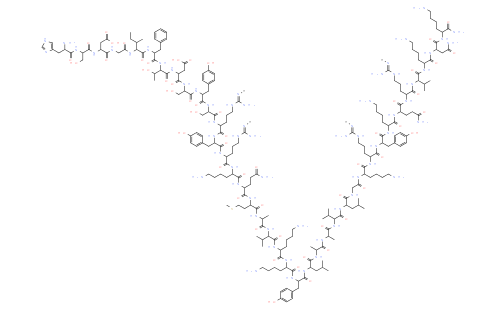PACAP-1-38
货号:
IP3120
品牌:
Jinpan

暂无详情
产品简介
| 有效期 | 2年 |
| 别名 | 体腺苷酸环化酶-活化聚肽 |
| 英文名称 | PACAP-1-38 |
| CAS | 137061-48-4 |
| 分子式 | C203H331N63O53S |
| 分子量 | 4534.26 |
| 储存条件 | -20°C |
| 纯度 | ≥96% |
| 外观(性状) | White Powder |
| 单位 | 瓶 |
| 生物活性 | PACAP (1-38), human, ovine, rat is a neuropeptide with 38 amino acid residues. PACAP (1-38) binds to PACAP type I receptor, PACAP type II receptor VIP1, and PACAP type II receptor VIP2 with IC50s of 4 nM, 2 nM, and 1 nM, respectively.[1-4] |
| IC50 | 4 nM (PACAP type I receptor); 2 nM (PACAP type II receptor VIP1); 1 nM (PACAP type II receptor VIP2)[1] |
| In Vitro | PACAP (1-38), human, ovine, rat is a fragment of pituitary adenylate cyclase activating polypeptide[1]. PACAP (1-38) shows high affinity for PACAP specific (PAC1) receptor in membranes from various tissues including the endocrine pancreas[2]. In vitro, PACAP (1-38) relaxes guinea-pig and rabbit tracheal smooth muscle precontracted by histamine and by acetylcholine. PACAP (1-38) also increases adenosine 3′:5′-cyclic monophosphate (cyclic AMP) in tracheal smooth muscle, providing a possible mechanism for the relaxant effect of PACAP (1-38)[3]. |
| In Vivo | PACAP (1-38) alone in sham animals does not result in changes in any of the retinal layers. PACAP (1-38) dissolved in solutio ophthalmica cum benzalkonio leads to significant protection in the retina in bilateral common carotid artery occlusion (BCCAO)-lesioned retinas; retinas treated with PACAP (1-38) eye drops have preserved structure compared to control retinas. OLM-ILM (outer limiting membrane-inner limiting membrane) distance is reduced by 49.7% (p<0.001) in BCCAO retinas compared to sham controls, but it is only 40.6% (p<0.001) in the eyes treated with PACAP (1-38) eye drops. A protection to a similar degree is found in the inner nuclear layer (INL) (BCCAO: 38.5%, PACAP (1-38): 30.5%; p<0.001), and inner plexiform layer (IPL) (BCCAO: 64.8%, PACAP (1-38): 38.2%; p<0.05), while no statistically significant attenuation of the damage is observed in the outer nuclear layer (ONL) (BCCAO: 36.5%, PACAP (1-38): 37.7%) or outer plexiform layer (OPL) (BCCAO: 53.0%, PACAP (1-38): 48.2%). The number of cells in the ganglion cell layer (GCL) is significantly decreased after BCCAO by 52.4% (p<0.05) and is significantly ameliorated by PACAP (1-38) eye drops (decreased by 25.9%; p<0.05)[4]. |
| SMILES | — |
| 靶点 | PACAP receptor |
| 动物实验 | Wistar rats (n=20:n=12 for histological analysis, n=8 for immunohistochemical analysis) weighing 250-300 are fed and watered ad libitum, under light/dark cycles of 12/12 h. Directly after the operation within 1 min, the right eye is treated with PACAP (1-38) eye drops (1 μg/drop). The vehicle used is benzalkonium-chloride in a concentration of 0.005%, as it is the most effective vehicle to achieve neuroprotection with PACAP1-27 eye drops. The left eye serves as a control, treated only with the vehicle. A group of animals serve as the sham-operated group that undergo anesthesia and all steps of the surgical procedure except ligation of the carotid arteries. Rats are treated twice a day with one drop, for 5 consecutive days[4]. |
| 数据来源文献 | [1]. Gourlet P, et al. Fragments of pituitary adenylate cyclase activating polypeptide discriminate between type I and II recombinant receptors. Eur J Pharmacol. 1995 Dec 4;287(1):7-11. [2]. Yamaguchi N. Pituitary adenylate cyclase activating polypeptide enhances glucose-evoked insulin secretion in the canine pancreas in vivo. JOP. 2001 Sep;2(5):306-16. [3]. Lindén A, et al. Inhibition of bronchoconstriction by pituitary adenylate cyclase activating polypeptide (PACAP 1-27) in guinea-pigs in vivo. Br J Pharmacol. 1995 Jul;115(6):913-6. [4]. Werling D, et al. Passage through the Ocular Barriers and Beneficial Effects in Retinal Ischemia of Topical Application of PACAP (1-38) in Rodents. Int J Mol Sci. 2017 Mar 21;18(3). pii: E675. |
| 规格 | 1mg |
H-Gly-Gly-Pro-OH 是由 3 个氨基酸构成的多肽。
